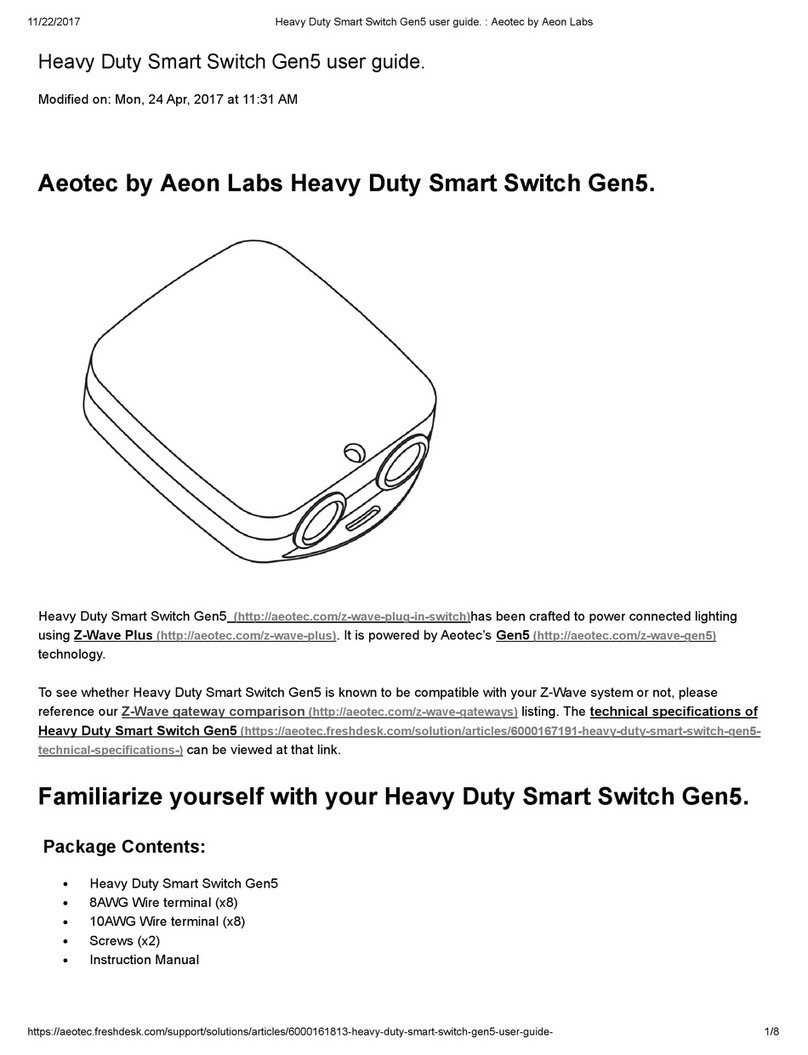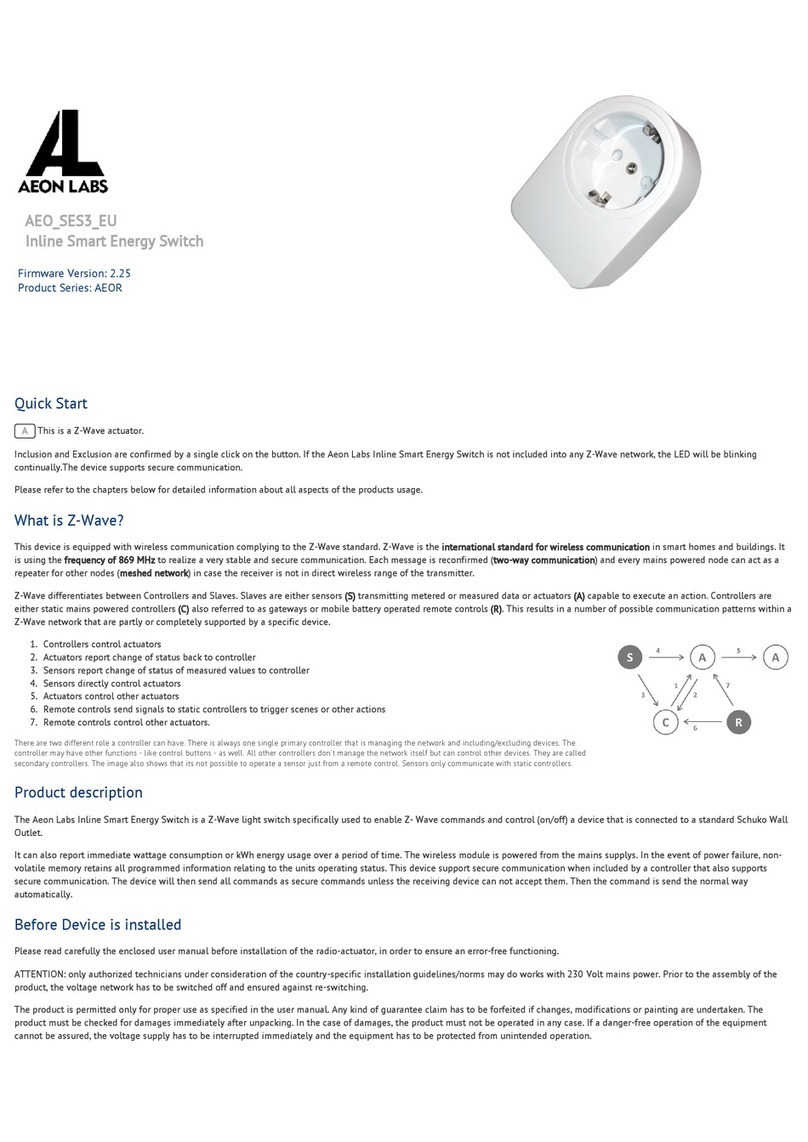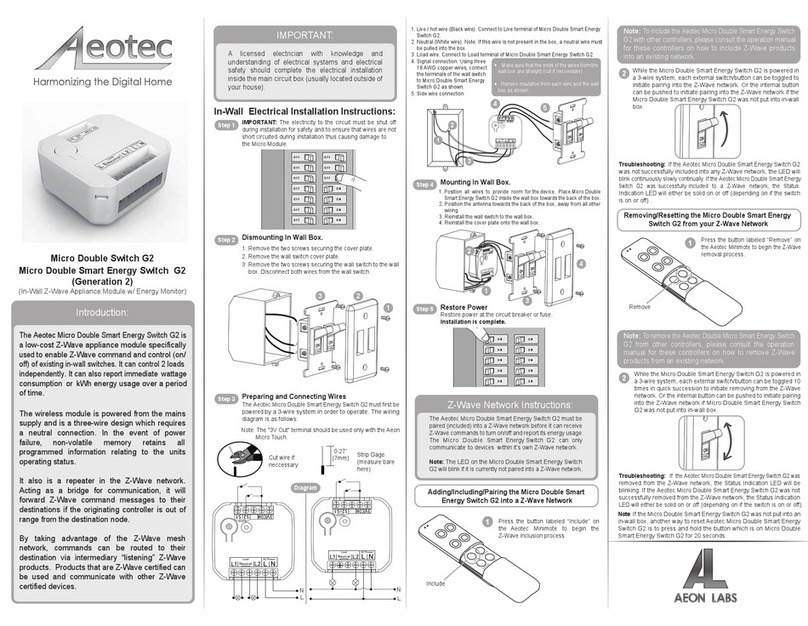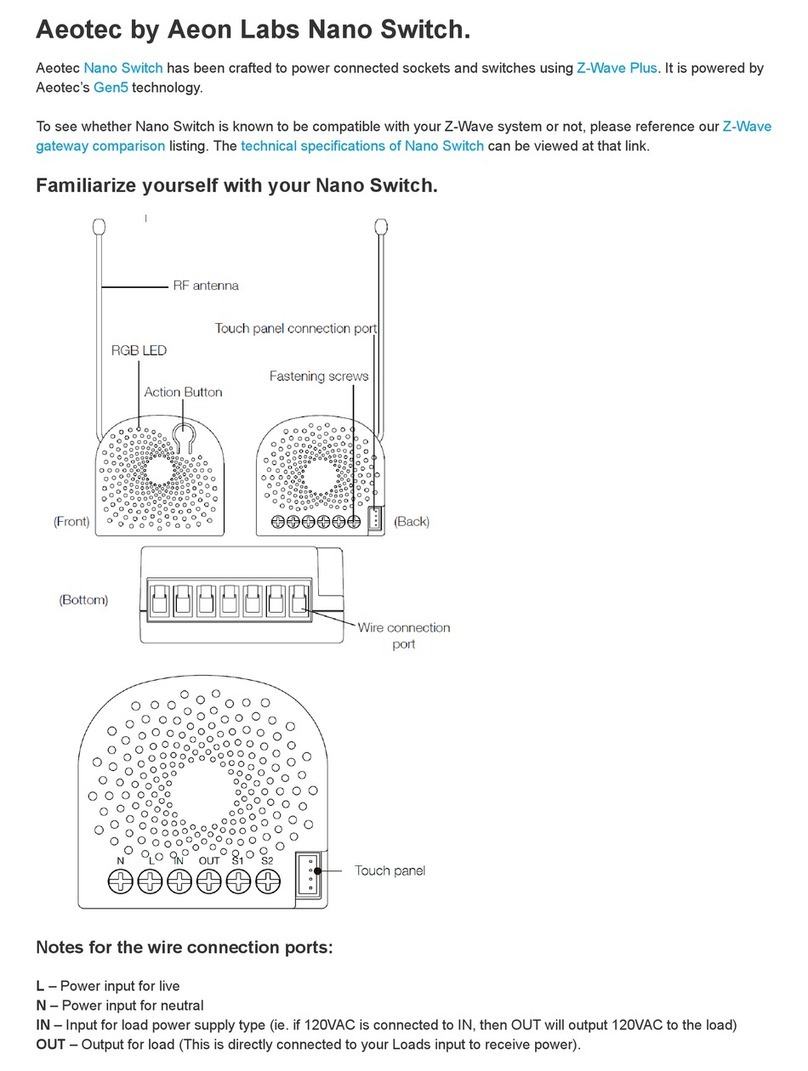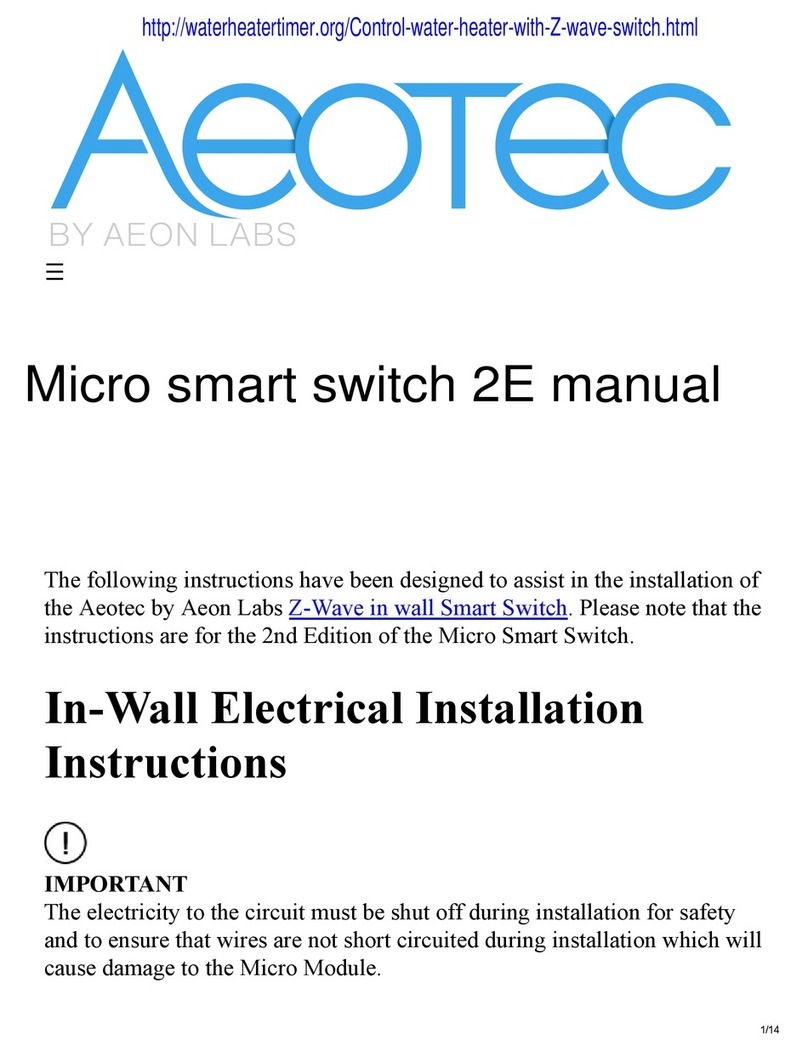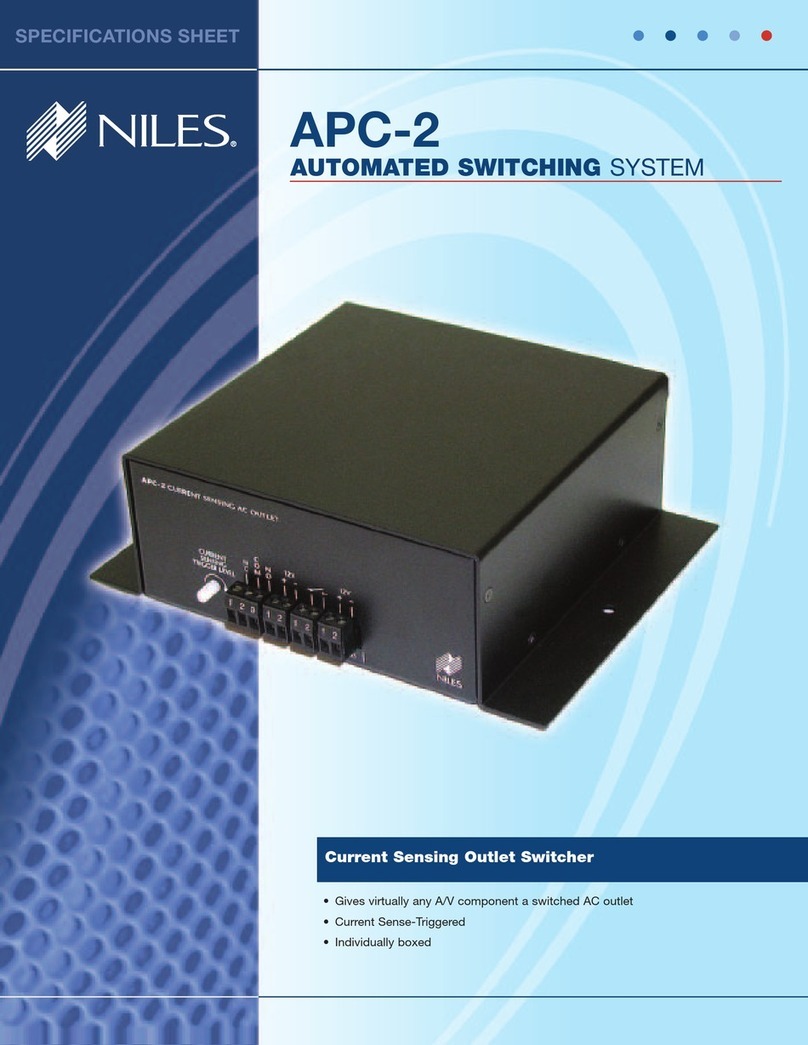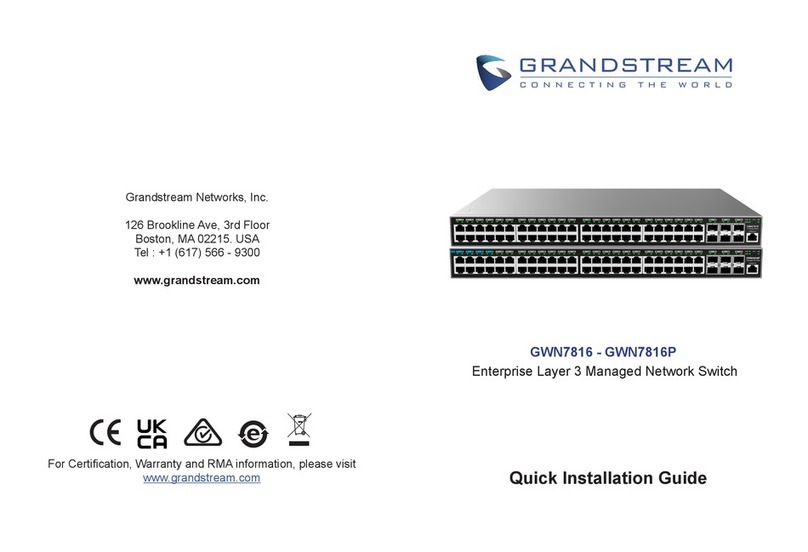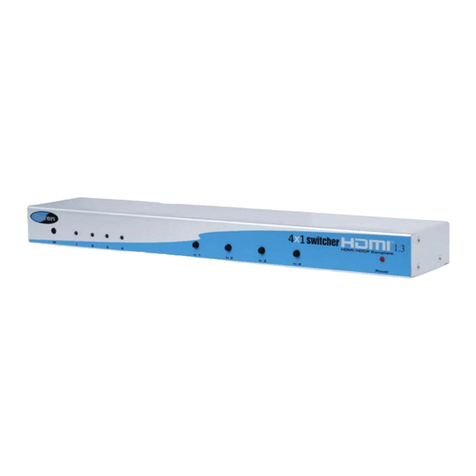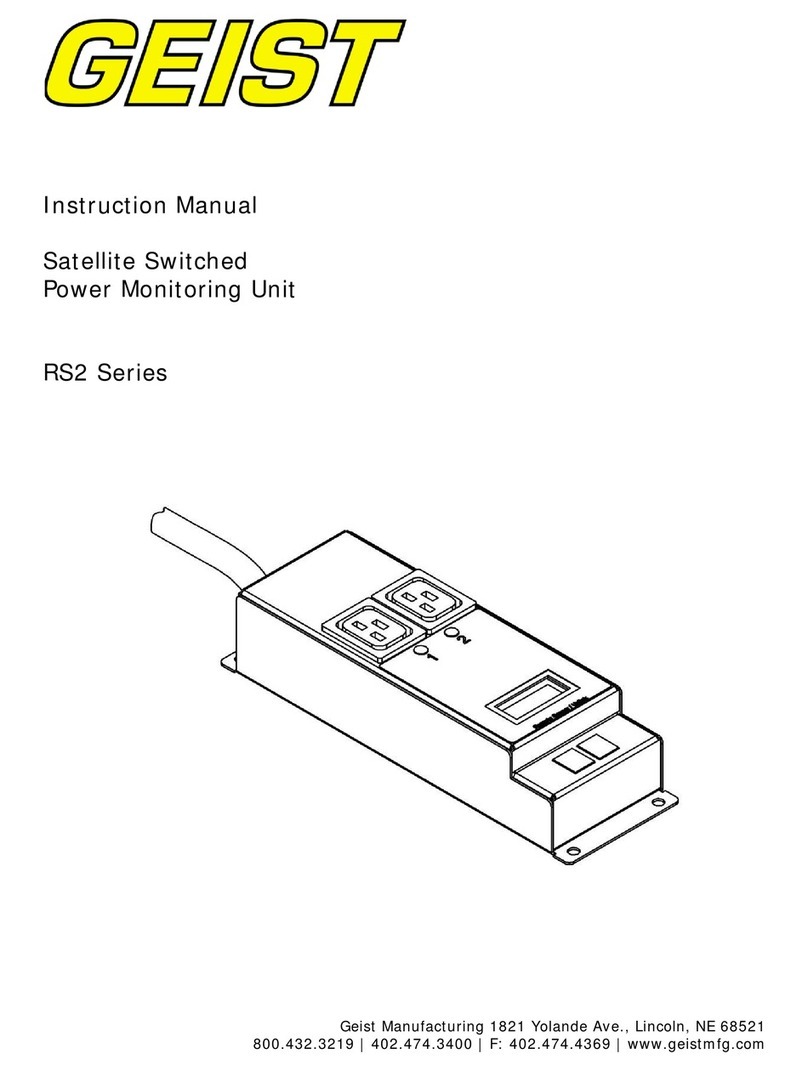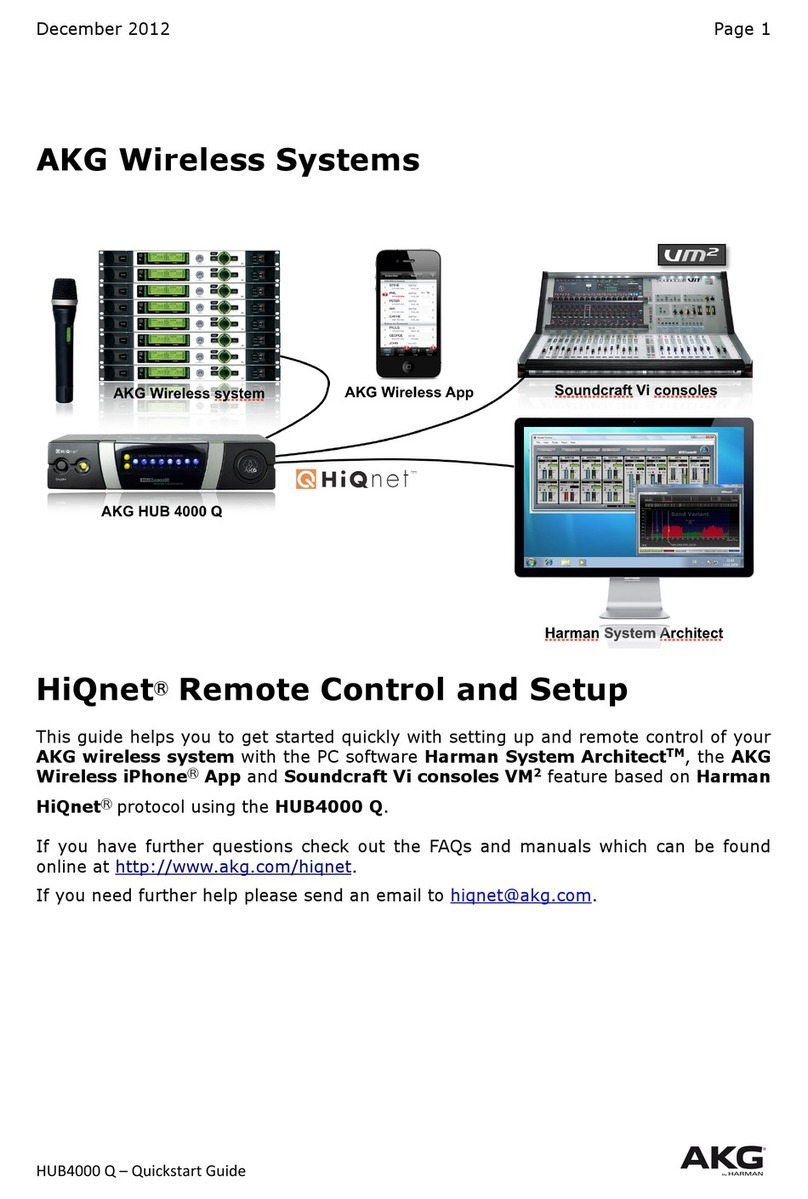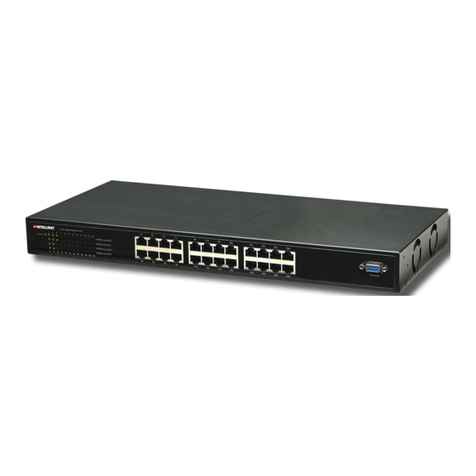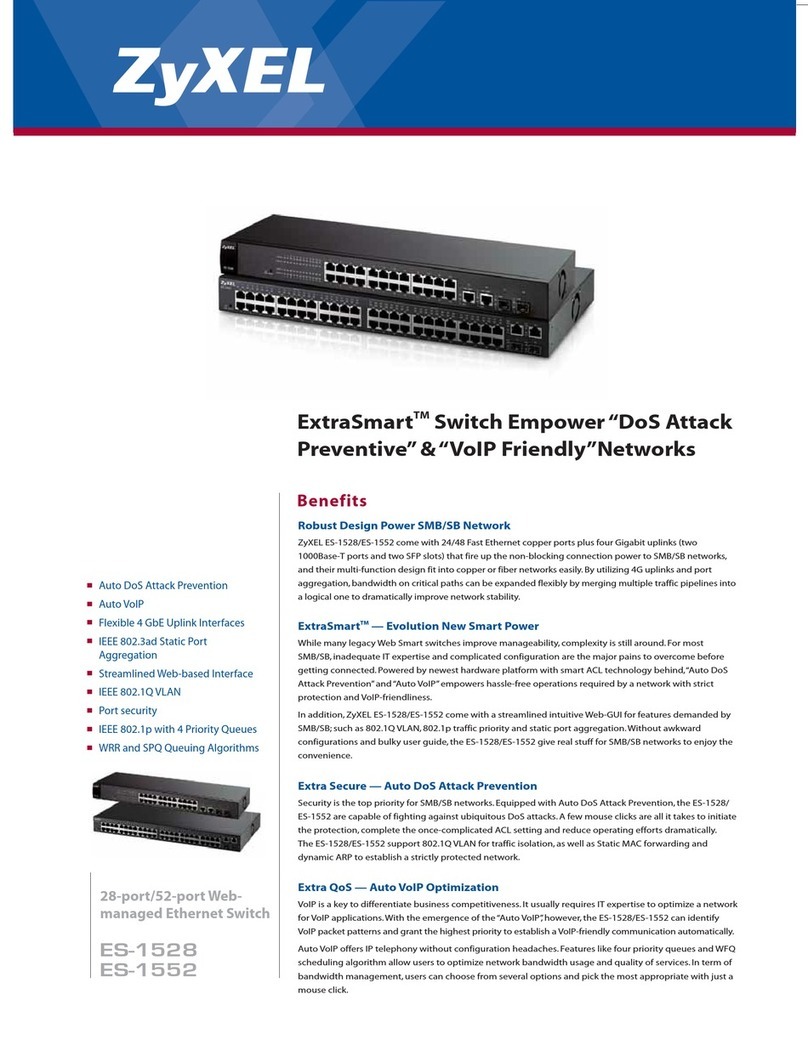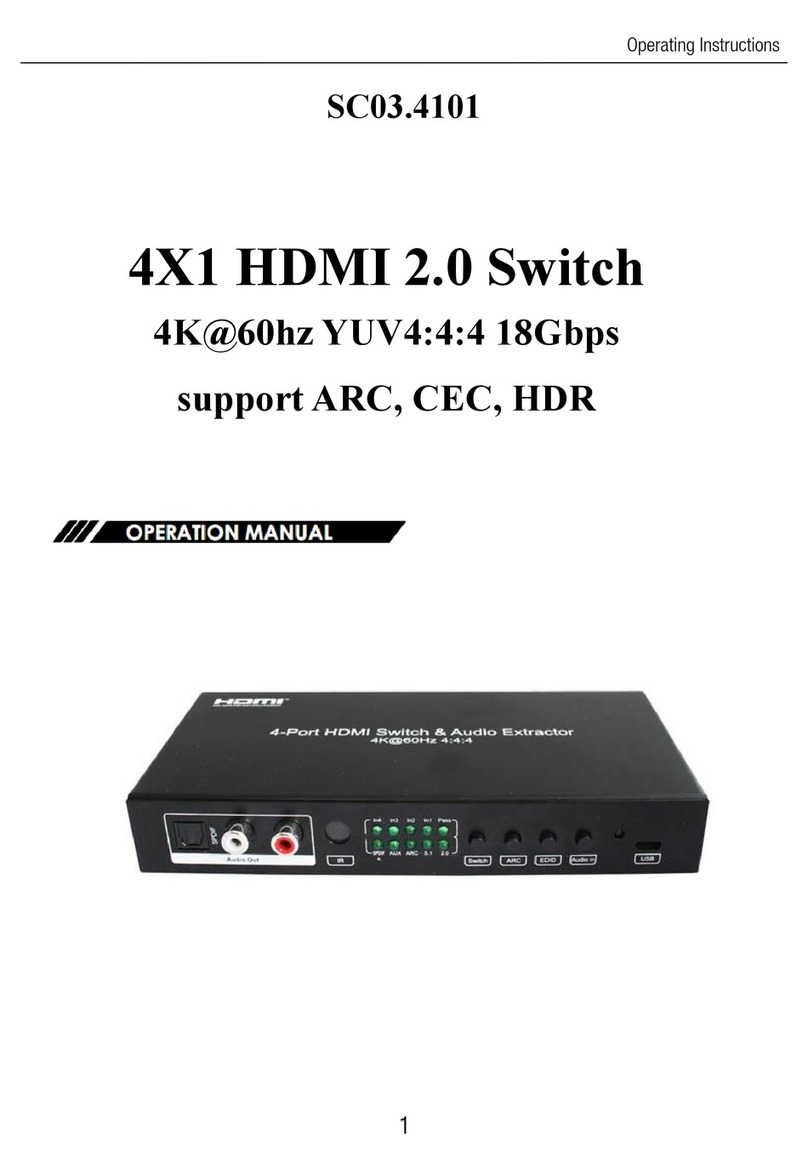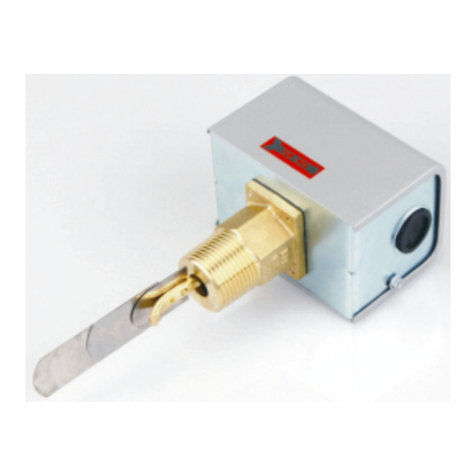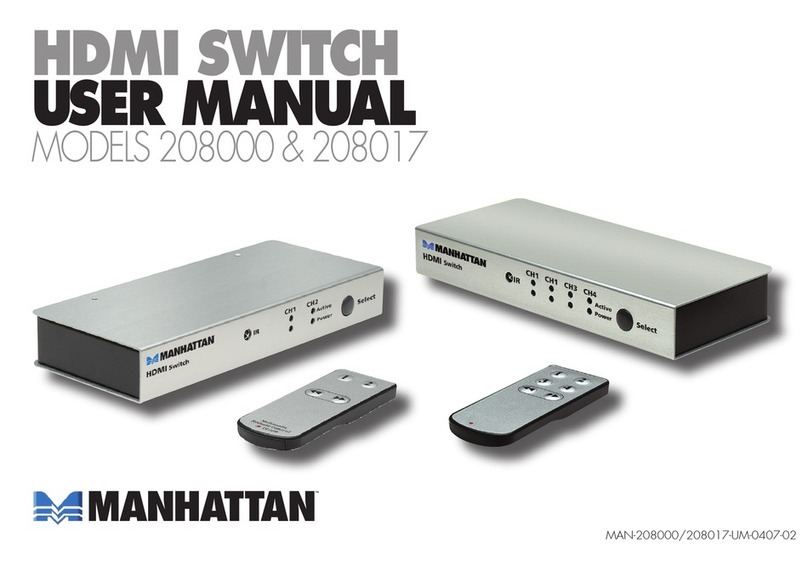Aeon Labs Aeotec Smart Switch 7 User manual

Smart Switch 7 (ZW175)
Quickstart
This is a secure On/Off Power Switch for Europe. To run this device please connect it to your mains power
supply. This product supports Security 2 Command Class. While a Security S2 enabled Controller is needed in
order to fully use the security feature. This product can be included and operated in any Z-Wave network with
other Z-Wave certified devices from other manufacturers and/or other applications.
SmartStart Learn Mode:
1. SmartStart enabled products can be added into a Z-Wave network by scanning the Z-Wave QR Code present
on the product with a controller providing SmartStart inclusion. No further action is required and the SmartStart
product will be added automatically within 10 minutes of being switched on in the network vicinity.
2. Indicator Light will become flash white light for 1s indicating the product has been powered, and then become
flash blue light indicating SmartStart Learn Mode starts.
3.It will become constantly bright yellow light after being assigned a NodeID.
4. If Adding succeeds, it will bright blue light for 2s and become Load Indicator Mode.
5. If Adding fails, it will bright red light for 2s and turn back to breathing blue light and then start SmartStart Learn
Mode again.
Note: The label of QR Code on the product and package are used for SmartStart Inclusion.
The Z-Wave DSK Code is at bottom of the package. Please do not remove or damage them.

Important safety information
Please read this manual carefully. Failure to follow the recommendations in this manual may be dangerous or
may violate the law. The manufacturer, importer, distributor and seller shall not be liable for any loss or damage
resulting from failure to comply with the instructions in this manual or any other material. Use this equipment only
for its intended purpose. Follow the disposal instructions. Do not dispose of electronic equipment or batteries in a
fire or near open heat sources.
What is Z-Wave?
Z-Wave is the international wireless protocol for communication in the Smart Home. This device is suited for use
in the region mentioned in the Quickstart section.
Z-Wave ensures a reliable communication by reconfirming every
message (two-way communication) and every mains powered
node can act as a repeater for other nodes (meshed network) in
case the receiver is not in direct wireless range of the transmitter.
This device and every other certified Z-Wave device can be used
together with any other certified Z-Wave device regardless of
brand and origin as long as both are suited for the same
frequency range.
If a device supports secure communication it will communicate
with other devices secure as long as this device provides the same or a higher level of security. Otherwise it will
automatically turn into a lower level of security to maintain backward compatibility.
For more information about Z-Wave technology, devices, white papers etc. please refer to www.z-wave.info.
Product Description
The Aeotec Smart Switch 7 is an elegant appearance, small size, easy to use, Smart Plug. This supports power
metering function, with high measurement accuracy, and more accurate knowledge of the power consumption of
the load, over-current, over-load and over-heat protection, which is more secure and reliable, scene
personalization and is more intelligent, Night Light Mode to reduce light pollution, S2 Security, which is safer
and more reliable and SmartStart, making inclusion more convenient.
Prepare for Installation / Reset
Please read the user manual before installing the product.
In order to include (add) a Z-Wave device to a network it must be in factory default state. Please make sure to
reset the device into factory default. You can do this by performing an Exclusion operation as described below in
the manual. Every Z-Wave controller is able to perform this operation however it is recommended to use the
primary controller of the previous network to make sure the very device is excluded properly from this network.
Reset to factory default
This device also allows to be reset without any involvement of a Z-Wave controller. This procedure should only
be used when the primary controller is inoperable.
If not, plug it into a wall socket and power on. To complete the reset process manually, press and hold the Action
Button for at least 15s and then release. The LED indicator will become breathing blue light, which indicates the
reset operation is successful. Otherwise, please try again.

Safety Warning for Mains Powered Devices
ATTENTION: only authorized technicians under consideration of the country-specific installation
guidelines/norms may do works with mains power. Prior to the assembly of the product, the voltage network has
to be switched off and ensured against re-switching.
Inclusion/Exclusion
On factory default the device does not belong to any Z-Wave network. The device needs to be added to an
existing wireless network to communicate with the devices of this network. This process is called Inclusion.
Devices can also be removed from a network. This process is called Exclusion. Both processes are initiated by
the primary controller of the Z-Wave network. This controller is turned into exclusion respective inclusion mode.
Inclusion and Exclusion is then performed doing a special manual action right on the device.
Inclusion
1. Plug the device into a power outlet.
2. Press the button on the device once to cancel the Smartstart mode.
3. Press the button on the device again.
Exclusion
1. Plug the device into a power outlet.
2. Press Action Button 2 times quickly.
Product Usage
Button Presses and LED reaction.
Button Press
Function when released.
LED Reaction
Power On
(Unpaired from the network).
(Paired into the network).
Breathes blue.
LED follows the state of load
(configurable).
QR Code Scan
Pairs into Z-Wave network.
Blue fast blink during pairing, then
solid blue for 2 seconds to indicate
success.
Tap or Click
Controls load state.
LED Follows load control state.
Press 2 times
slowly
Enters pair mode.
Blue fast blink, after first Click Red
and after second Click Orange.
The LED change to Green, if the
device paired
Press 2 times
fastly
Enters unpair mode
After press 2 times the led indicate
purple.
After inclusion, the LED flashes Blue
Press 3 times
Disable the Alarm Response
LED stops flash
Press and hold
for 2 to 5
seconds.
Toggles LED display mode when
SS7 is paired.
Yellow LED
Enabled - LED follows ON/OFF state.
Disabled - LED is disabled
Press and hold
for 5 to 10
seconds.
Test communication quality
Indicator Light will become cyan light
when press, and quickly flash cyan
light when release, indicating start to
test communication quality between
the product and Node 1.
At the end of the test, Indicator Light
will display the colour according to the
communication quality.

Good = green light for 2s.
General = yellow light for 2s.
Poor = red light for 2s.
Press and hold
for 10 to 15
seconds.
Reset overload alarm and over
current Alarm
Red LED flashes
Press and hold
for 15 to 20
seconds.
Stay in Z-Wave network, but factory
resets all settings back to default.
Red LED Flashes faster.
Press and hold
for 20 seconds
and more.
Completely factory reset and
remove from Z-Wave network.
Breathes Blu
Quick trouble shooting
Here are a few hints for network installation if things dont work as expected.
1. Make sure a device is in factory reset state before including. In doubt exclude before include.
2. If inclusion still fails, check if both devices use the same frequency.
3. Remove all dead devices from associations. Otherwise you will see severe delays.
4. Never use sleeping battery devices without a central controller.
5. Dont poll FLIRS devices.
6. Make sure to have enough mains powered device to benefit from the meshing
Association - one device controls an other device
Z-Wave devices control other Z-Wave devices. The relationship between one device controlling another device
is called association. In order to control a different device, the controlling device needs to maintain a list of
devices that will receive controlling commands. These lists are called association groups and they are always
related to certain events (e.g. button pressed, sensor triggers, ...). In case the event happens all devices stored in
the respective association group will receive the same wireless command wireless command, typically a 'Basic
Set' Command.
Association Groups:
Group Number
Maximum
Nodes
Description
1
5
Z-Wave Plus Lifeline.
2
5
Retransmit a Basic Set, Binary Switch Set or Scene Activation Set to the nodes
associated.
Configuration Parameters
Z-Wave products are supposed to work out of the box after inclusion, however certain configuration can adapt
the function better to user needs or unlock further enhanced features.
IMPORTANT: Controllers may only allow configuring signed values. In order to set values in the range 128 ...
255 the value sent in the application shall be the desired value minus 256. For example: To set a parameter to
200 it may be needed to set a value of 200 minus 256 = minus 56. In case of a two byte value the same logic
applies: Values greater than 32768 may needed to be given as negative values too.
Parameter 4: Over-load protection
Define a threshold power and automatically turn off switch when the load connected bypasses the maximum
allowed power regardless of always on setting.Over-load protection will be active if the load power exceeds the
setting and lasts for more than 30s. If be active, Indicator Light will become red light blinking and the product
will send out Notification Report (Over-load detected), and disable the function that manually or RF control the
switch state until users set Protection State to be unprotected through the Gateway or Controller. Even power off
will still keep Protection State.
Size: 2 Byte, Default Value: 2415

Setting
Description
0
Disable over-load protection
1 - 2415
Threshold power is 1-2145W
Parameter 8: Alarm Response
Enabled by (Alarm Settings), and determines what the switch does in the case an alarm is triggered.When
receives any alarm enabled by Alarm Settings, Indicator Light will keep blinking based on Parameter 0x12 (18).
It will prohibit user from manually or RF control the switch state until the alarm is disable.
Size: 1 Byte, Default Value: 0
Setting
Description
0
Disable, no reaction to alarm settings
1
Switch is ON
2
Switch is OFF
3
Switch will turn ON in 5 seconds, and then turn OFF in 5 seconds in a cycle until user disables
the alarm manually
Parameter 9: Alarm Settings
Determine if alarms are enabled in Switch, and what Switch will react to which alarm. The format of the
parameter is Bit field (Checkboxes). The parameter MUST be treated as a bit field where each individual bit can
be set or reset. A graphical configuration tool SHOULD present this parameter as a series of checkboxes. Please
refer to the manual for more details about supported Notification Type and Notification Event.
Size: 2 Byte, Default Value: 0
Setting
Description
1
Access Control trigger state
256
Smoke Alarm
512
CO Alarm
1024
CO2 Alarm
2048
Heart Alarm
4096
Water Alarm
8192
Access Control
16384
Home Security
Parameter 10: Setting to disable alarm
Determines the method of disabling the alarm of the device.Note:Power off will also disable the alarm response
without any limitation.
Size: 2 Byte, Default Value: 0
Setting
Description
0
Can be disabled by 3x tapping Action Button within 1 second
1
Can be disabled when receives a State Idle corresponding to the alarm. Note: If Access Control is
enable, it also can be disabled when receives the reversal state of window/door.
10 - 255
Sets the duration of the alarm in seconds(i.e. Customer sets this setting to 50, the alarm state of
the Switch will disable after 50 seconds)

Parameter 18: LED blinking frequency
When receiving the enable Alarm, it will flash according to the blink frequency configured by this parameter
until the Alarm is disable. Brightness level and color is based on current indicator. If the value of brightness
level and color is 0, it will flash based on last visible color.
Size: 1 Byte, Default Value: 2
Setting
Description
1 - 9
Set amount of blinks per seconds.
Parameter 19: Start or stop LED blinking.(Write Only)
The parameter can be used to test the effect of LED blinking.
Size: 2 Byte, Default Value: 0
Setting
Description
0
Stop blinking.
1 - 255
Set the duration and start the blinking process. * This sets the timeframe of blinking in seconds. *
Once the duration ends, the blinking will stop.
Parameter 20: Action in case of power out.
Action in case of power out.
Size: 1 Byte, Default Value: 0
Setting
Description
0
Last status
1
Switch is on
2
Switch is off
Parameter 80: Configure what command will be sent via Lifeline when switch state has changed.
Configure what command will be sent via Lifeline when switch state has changed.
Size: 1 Byte, Default Value: 2
Setting
Description
0
None
1
Basic Report
2
Binary Switch Report
Parameter 81: Load Indicator Mode setting.
Note: Configuring brightness and color of Indicator Light in different time/status of different modes will be
saved in the current setting mode. Please refer to the manual for more details.
Size: 1 Byte, Default Value: 2
Setting
Description
0
Disable Mode
1
Night Light Mode
2
ON/OFF Mode
Parameter 82: Configure the enable and disable time of Night Light Mode
If you want to set Night Light Mode to be enable at 19:00 at night and disable at 07:30 in the morning, you just
need to configure:Value1=0x13, Value2=0x00, Value3=0x07, Value4=0x1E.
Size: 4 Byte, Default Value: 301991936

Setting
Description
0 - 2147483647
Value1=Enable Hour, Value2=Enable Minute, Value3=Disable Hour, Value4=Disabale Minute
Parameter 91: Threshold Power (W) for inducing automatic report.
Threshold Power (W) for inducing automatic report.
Size: 2 Byte, Default Value: 0
Setting
Description
0
Disable
1 - 2300
1-2300W
Parameter 92: Threshold Power Consumption (kWh) for inducing automatic report.
Threshold Power Consumption (kWh) for inducing automatic report.
Size: 2 Byte, Default Value: 0
Setting
Description
0
Disable
1 - 10000
1-10000kWh
Parameter 93: Threshold Current (A) for inducing automatic report.
Threshold Current (A) for inducing automatic report.
Size: 1 Byte, Default Value: 0
Setting
Description
0
Disable
1 - 100
0.1-10A. Unit is 0.1A.
Parameter 101: Configure which meter reading will be periodically report via Lifeline.
The format of the parameter is Bit field (Checkboxes). The parameter MUST be treated as a bit field where each
individual bit can be set or reset. A graphical configuration tool SHOULD present this parameter as a series of
checkboxes.Note:The sending frequency is related to Configuration Parameter 0x6F (111).
Size: 4 Byte, Default Value: 15
Setting
Description
1
Power Consumption
2
Power
4
Voltage
8
Current
Parameter 111: Configure the sending frequency of Meter Report.
Configure the sending frequency of Meter Report.
Size: 4 Byte, Default Value: 600
Setting
Description
0
Disable
600 - 2592000
600-2592000s. (10minute-30day)
Parameter 255: Factory Reset or Initialization (Write Only)
Factory Reset or Initialization (Write Only)
Size: 1 Byte, Default Value: 0

Setting
Description
1431655765
Factory Reset: Restore the product to factory settings and remove from the network.
0
Initialization: Initialize all configuration parameters to default values.
Technical Data
Dimensions
42 x 42 x 70 mm
Weight
56 gr
Hardware Platform
ZM5101
EAN
1220000016415
IP Class
IP 20
Voltage
230 V
Load
10A
Device Type
On/Off Power Switch
Network Operation
Always On Slave
Z-Wave Version
6.81.03
Certification ID
ZC10-19066544
Z-Wave Product Id
0x0371.0x0003.0x00AF
Outdoor Use
ok
Sensors
CurrentPowerVoltage
Supported Notification Types
Power ManagementSystem
Z-Wave Scene Type
Scene
Color
White
Firmware Updatable
Updatable by Consumer by RF
Supported Meter Type
Electric Energy
Frequency
Europe - 868,4 Mhz
Maximum transmission power
5 mW
Supported Command Classes
Application Status
Association Grp Info
Association V2

Basic
Clock
Configuration
Device Reset Locally
Firmware Update Md V4
Manufacturer Specific V2
Meter V4
Notification V4
Powerlevel
Protection V2
Scene Activation
Scene Actuator Conf
Security
Security 2
Supervision
Switch Binary
Switch Color
Switch Multilevel V2
Transport Service V2
Version V2
Zwaveplus Info V2
Controlled Command Classes
Basic
Notification V4
Scene Activation
Switch Binary
Explanation of Z-Wave specific terms
Controller —is a Z-Wave device with capabilities to manage the network. Controllers are typically
Gateways,Remote Controls or battery operated wall controllers.
Slave —is a Z-Wave device without capabilities to manage the network. Slaves can be sensors, actuators
and even remote controls.
Primary Controller —is the central organizer of the network. It must be a controller. There can be only
one primary controller in a Z-Wave network.
Inclusion —is the process of adding new Z-Wave devices into a network.
Exclusion —is the process of removing Z-Wave devices from the network.
Association —is a control relationship between a controlling device and a controlled device.
Wakeup Notification —is a special wireless message issued by a Z-Wave device to announces that is
able to communicate.
Node Information Frame —is a special wireless message issued by a Z-Wave device to announce its
capabilities and functions.
This manual suits for next models
1
Table of contents
Other Aeon Labs Switch manuals
Popular Switch manuals by other brands
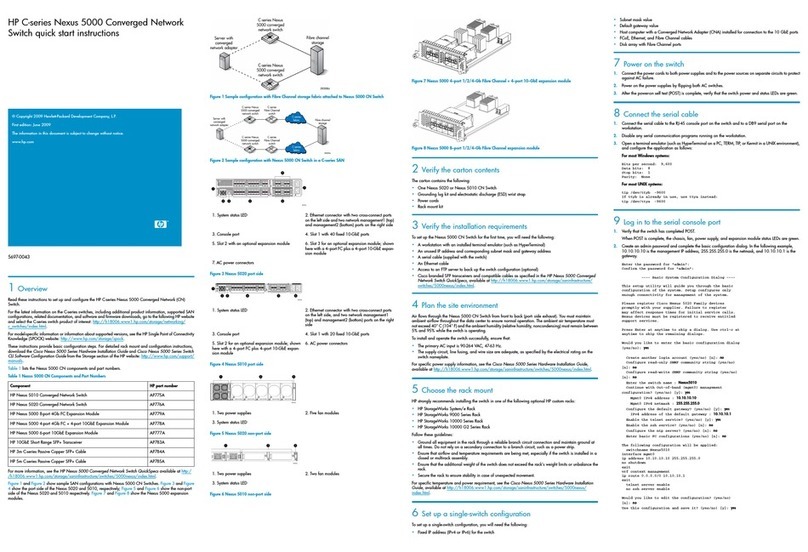
HP
HP AP775A - Nexus Converged Network Switch 5010 Quick start instructions
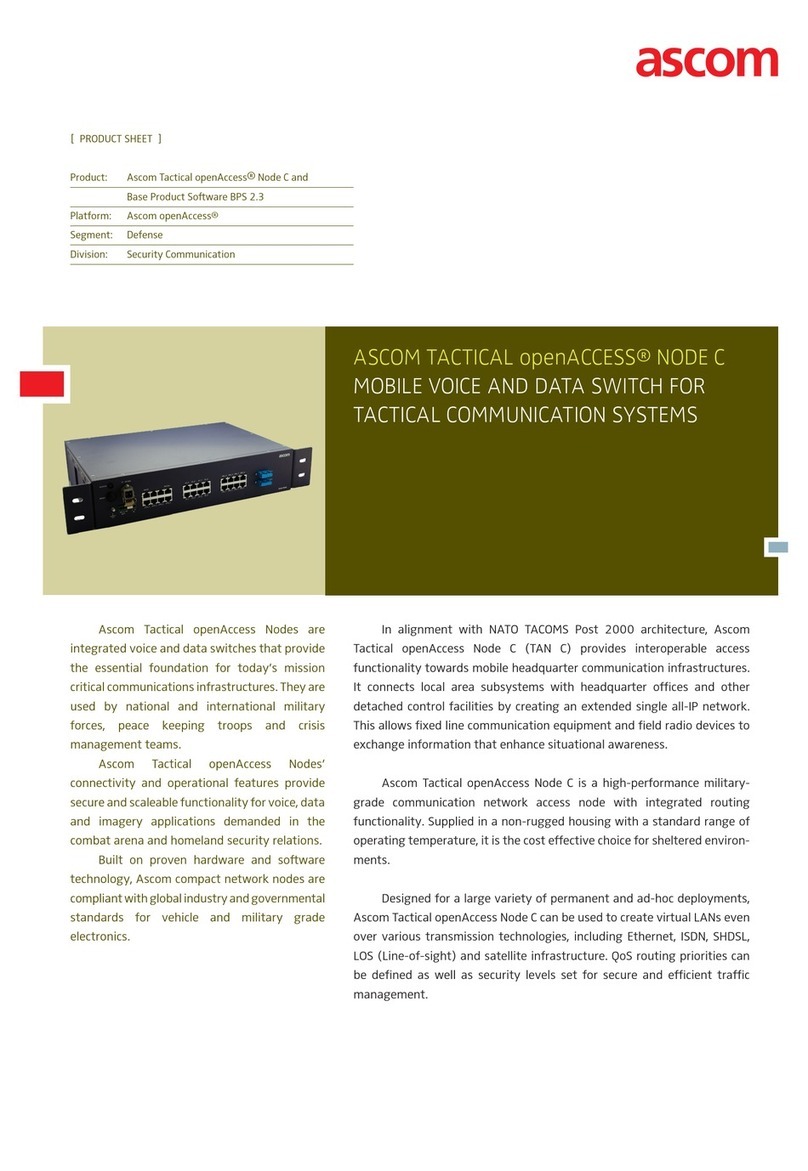
ASCOM
ASCOM TACTICAL OPENACCESS NODE C Product sheet
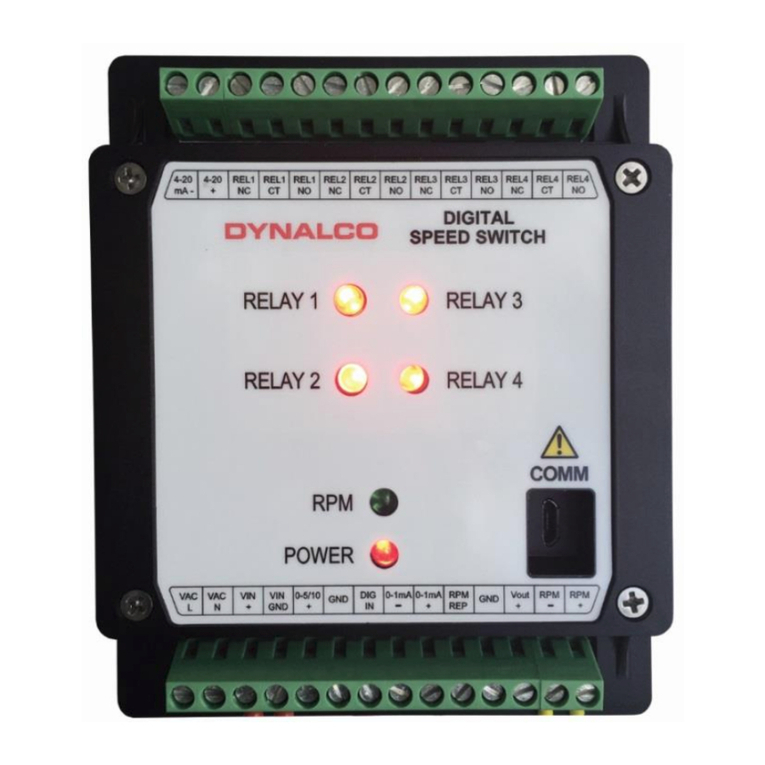
Barksdale
Barksdale Dynalco SST7200 Installation and operation manual
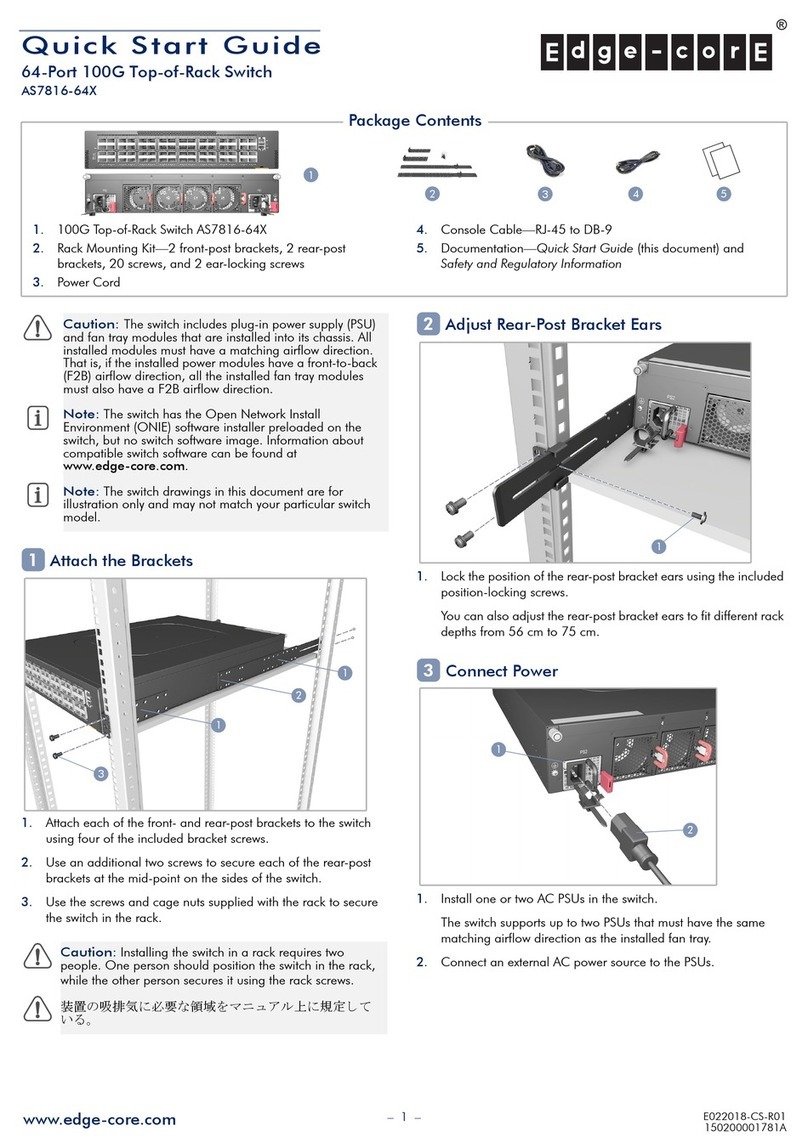
Edge-Core
Edge-Core AS7816-64X quick start guide
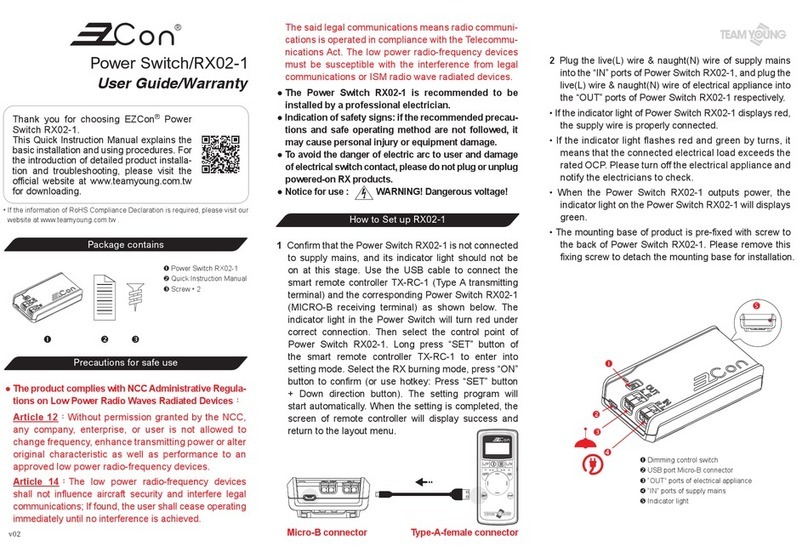
Team Young
Team Young EZCon RX02-1 User guide & warranty
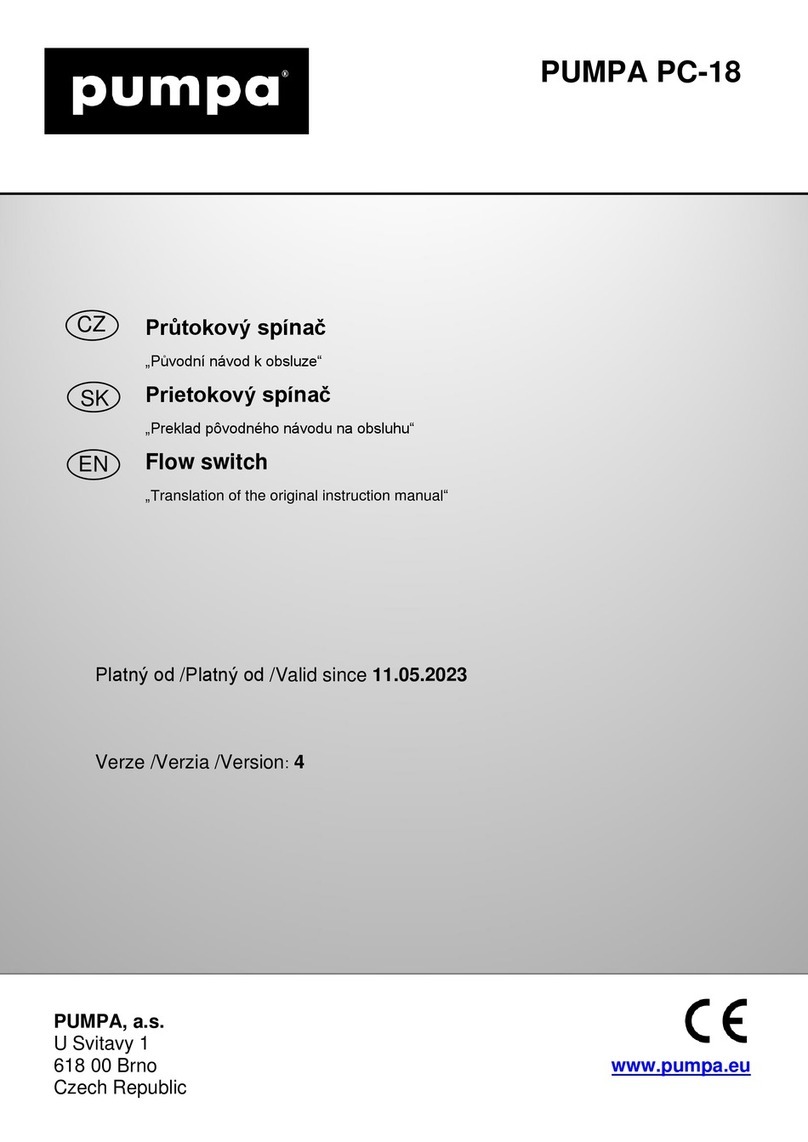
pumpa
pumpa PC-18 Translation of the original instruction manual
